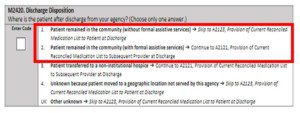Posted Monday, May 16, 2022
Understand the two new Quality Measures Transfer of Health Information to the Patient and Transfer of Health Information to the Provider
OASIS-E implementation launches on January 1, 2023. With less than eight full months to prepare, now is a good time to become familiar with how the new OASIS-E Quality Measures and how using the latest guidance to answer M2420 Discharge Disposition will impact the Transfer of Health (TOH) calculation. The two new measures include Transfer of Health Information to the Provider and Transfer of Heath Information to the Patient.
Essentially, these measures will be favorable for the agency if they provide the patient’s reconciled medication list to the subsequent provider or to the patient/family/caregiver in certain situations. The situations that trigger which of these two quality measures “in play” are driven by the agency response to M 2420 Discharge Disposition at discharge or at Transfer to inpatient facility Reason for Assessment types 6 and 7.
Let’s start with discussing newer guidance that should already be in place regarding M2420.
Recently, CMS released new guidance on how to appropriately answer M2420 Discharge Disposition.

M2420 includes 5 responses. The new guidance only affects responses 1 and 2 regarding a patient who remains in the community with 1) without formal assistive services or 2) with formal assistive services.
Answers 3) non-institutional hospice, 4) an unknown reason due to a geographic relocation or UK) unknown due to another non-geographic reason, remain unchanged.
To answer 2420 correctly, we will ignore old definitions of without formal assistance and with formal assistance and adopt this new guidance.
Answer 1 will refer to patient discharged to any community setting (no inpatient setting) with or without assistive services except for the services of another home health or “home” hospice. Patients discharged with or without formal assistive services can include those remaining in a private home, apartment, board and care home, assistive living, group home, or transitional living situation.
Answer 2 is chosen when the patient was discharged from your agency and received the services of another home health agency.
Answer 3 (which hasn’t changed) will remain the correct response for those patients discharged to a non-inpatient hospice.
Start making these changes now to correctly answer this question. CMS released new guidance.
For a quick and easy video explanation, visit this link and navigate to the video tab to view “M2420 Discharge Disposition -New Coding Guidance to Support TOH Measures.”
Transfer of Health Information to the Provider and Transfer of Health Information to the Patient measure two separate and distinct situations. Both require a home health agency to provide a current reconciled medication list upon transfer or discharge.
Transfer of Health Information to the Patient
Agencies will be measured on this process when the answer to M2420 is 1,4 or UK. indicating the patient is not receiving services from a subsequent provider and remains in the community. The agency in these conditions will be required to answer OASIS E item A2123 (1) yes or (2) no indicating whether a reconciled medication list has been provided to the patient, family, or caregiver. “Yes” answers will be considered a favorable outcome for the agency.
Transfer of Health Information to the Provider
For a patient who remains in the community with formal assistive services of another home health agency or a “home” hospice, response 2 or 3 on M2420 A there is a separate but similar process measure completed. In this condition the agency is directed to answer the new OASIS E item A2121 Provision of Current Reconciled Medication List to Subsequent Provider at Discharge with a (1) yes or (2) no response indicating whether a reconciled medication list has been sent to the subsequent provider.
For further clarity, CMS defines “subsequent provider” as the following: short term general hospital, SNF, intermediate care, home under care of another organized home health service organization or hospice, hospice in an institutional facility, a swing bed, an IRF, LTCH, a Medicaid nursing facility, an inpatient psychiatric facility, or a critical access hospital.
Patients transferred to an inpatient facility and discharged (RFA 6 or 7), agencies will be required to answer the new OASIS-E item A2120, Provision of Current Reconciled Medication List to Subsequent Provider at Transfer.
Agencies will succeed in this measure if they indicate A2120/A2121= 1 Yes- Current reconciled medication list provided to the subsequent provider.
Need more information about how the new OASIS-E rules will impact home health or hospice agency data collection? Now is the time to reinforce your knowledge of the coming changes. To tap into Corridor’s deep expertise regarding OASIS-E and other coding and regulation updates, call us at 866-263-3795.
About Corridor
For over 30 years, Corridor has partnered with home-based care providers, delivering powerful solutions to support the unique challenges of caring for patients in the home. Our team of operating executives, clinicians, and nationally renowned industry experts have run provider organizations and resolved the same challenges you face.
To receive the most important industry updates, insights and news impacting home health and hospice, please make sure to sign up for our weekly newsletter.





